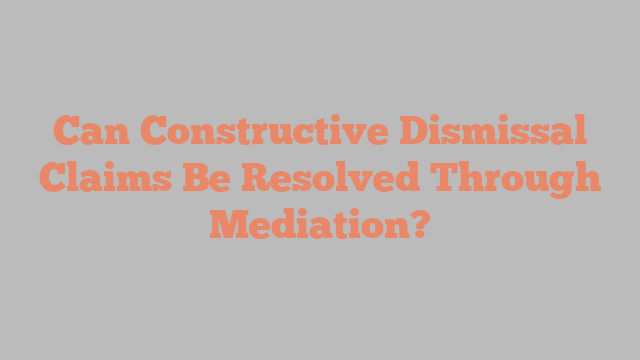Constructive Dismissal Claims Be Resolved
In some cases, an employer’s behaviour can make a working environment so intolerable that an employee feels they have no choice but to leave their job. This is known as constructive dismissal. It is usually the result of a series of events that culminate in ‘the last straw’, such as a serious breach of an employment contract or the employer behaving unreasonably towards the employee. It is important that employees take care when deciding to resign from their jobs, as doing so can have significant and lasting consequences for their careers and financial security.
The first step in making a claim for constructive dismissal is to gather as much evidence as possible to support your case, whether it progresses through ADR or goes to court. This should include any written documents pertaining to the issue (including notes from one-on-one meetings or reviews), emails and any other correspondence. If you are able to secure witness statements from colleagues, this will be beneficial in establishing your position.
It is also a good idea to consider how the issue has developed over time and what the overall impact has been on your work performance. It is helpful to note if you have made any formal or informal grievances and what the outcome of those was. You can then refer back to those when you are arguing that your employer has fundamentally breached your contract and/or acted unreasonably towards you.

Can Constructive Dismissal Claims Be Resolved Through Mediation?
A fundamental breach can relate to either an express or implied term of your employment contract and can involve either a direct breach or indirect breach. Direct breaches of an express term, for example, would be if your employer reduced your salary without your agreement. Indirect breaches of an implied term, on the other hand, could be if your employer refused to address concerns you raised about harassment or a toxic work environment.
Once you have gathered as much evidence as possible, it is time to start thinking about how you are going to present your case. An experienced employment lawyer can help with this.
Before taking action, it is a good idea to try and resolve the matter through mediation. This is a free, voluntary process set up by the Workplace Relations Commission and provides an opportunity for both sides to explain their position and to see if they can reach an agreement.
However, if no resolution can be reached through mediation, it is likely that the matter will have to be heard in court. An important point to bear in mind is that a court will have a view on what constitutes a constructive dismissal lawyer and it will be up to the court to determine what compensation, if any, you should receive. It is therefore advisable to consult with an employment law specialist before taking the steps required to bring a constructive dismissal claim.
